If you hit the ground before contacting the golf ball, you are guilty of “scalfing” or hitting a “fat” shot, a real block to low scoring.
Hitting the ground first is bad on two counts. First, it slows the club head an instant before its all-important contact with the ball. Second, it produces poor contact as grass and/or earth come between the clubface and the ball.
There are several causes of, and cures for, fat shots. We will elaborate on some of the most common errors and corrections further in this article.
In doing so we will refer to the “suspension point” of the swing. This is the center of the golfer’s spine at the base of his or her neck.
This is the point of a golfer’s body which should be correctly positioned during the swing, lest bad shots including the scalf result. The suspension point should remain constant throughout the swing.
Here are 4 causes of a fat shot in golf:
- Crouching at the address position, thus lowering the suspension point
- Lowering the suspension point during the swing
- Improperly fitted clubs that are too “whippy” for your swing
- During the swing, increasing the angle formed by the arms and club shaft
Table of Contents
1. Crouching at the address position, thus lowering the suspension point
This is probably the most common cause of fat shots. The player positions himself in an address position that has his suspension point closer to the ball than the total distance formed by the length of his arms and the part of the club below his hands.
This crouching, and the lowering of the suspension point that results, causes a bent arm position at address. Obviously, if the player maintains this incorrect suspension point position up to and during impact, and if he correctly extends his arms when club meets ball, then his extended arms will cause the club head to be lower at impact than it was at address.
The club head will cut into the ground behind the ball. Your shot will finish far short of the target, especially if the turf is soggy.
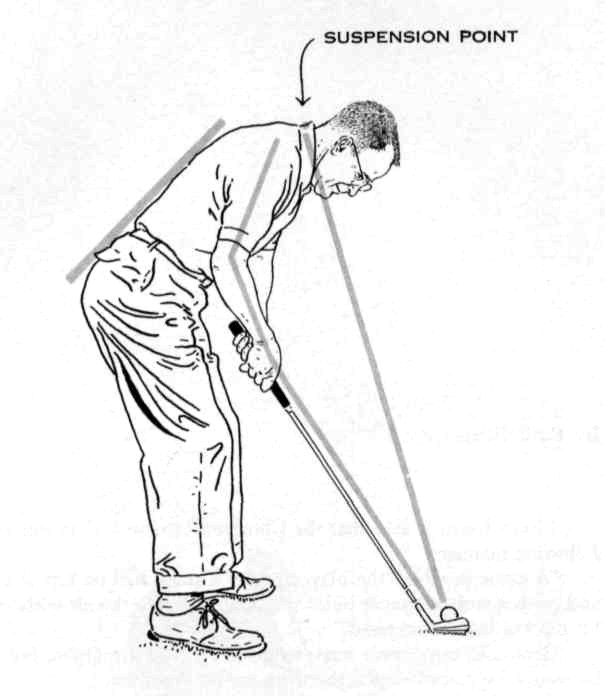
Fix: Shorten the swing radius or raise the suspension point
Because the radius of the swing arc (formed by the arms and club) is longer than the distance from the suspension point to the ball, an obvious correction is to shorten the radius.
This is done simply by shortening one’s grip on the club “choking up,” as they call it in baseball. The advantage of this correction is that it eliminates the schaff almost immediately. The disadvantage is that by shortening the radius of the swing, you automatically shorten the swing, and usually lose distance.
The second correction raising the suspension point if anything, will widen your swing arc by causing you to address the ball with the arms more extended. More distance may result. You raise the suspension point by merely addressing the ball with a more upright posture.
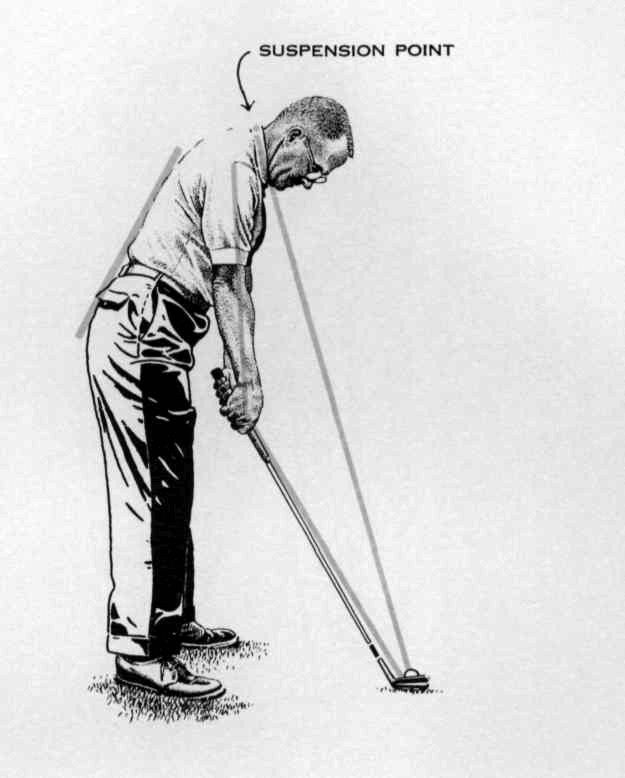
2. Lowering the suspension point during the swing
Even a golfer with a good posture at the address position may hit fat shots if he ducks his head — thus lowering his suspension point during his backswing or downswing.
This more subtle cause of scalfing also causes the suspension point to be closer to the ball at impact than the total length of the swing’s radius — the arms and club.
Obviously the player cannot hit the ball squarely with arms extended. He must either hit it fat or fold his arms to compensate for the shortened distance between the suspension point and the ball.
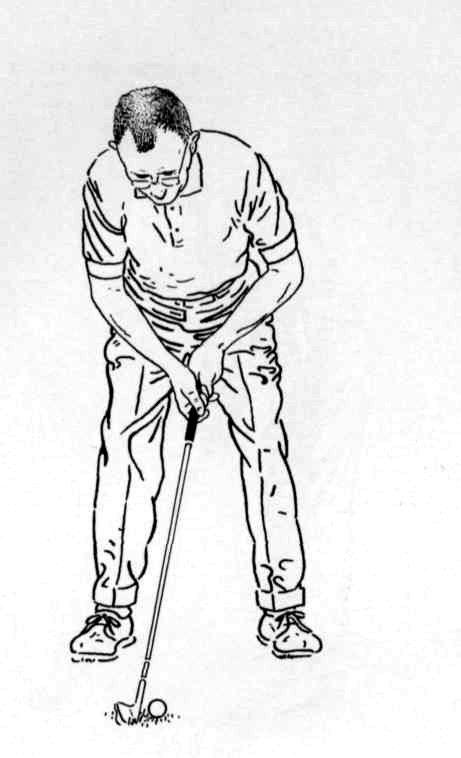
Fix: Maintain a consistent distance from the suspension point to the ball throughout the swing
The cure in this case is somewhat more difficult to accomplish since it involves avoiding any ducking of the head during the swing.
To keep from ducking the head, I would advise swinging without a club, while your forehead is pressed against a vertical object such as a tree, post or wall.
This will give you an idea of how it feels to swing without lowering your head in effect, without lowering your suspension point. Then duplicate this feeling without the post and with a club.
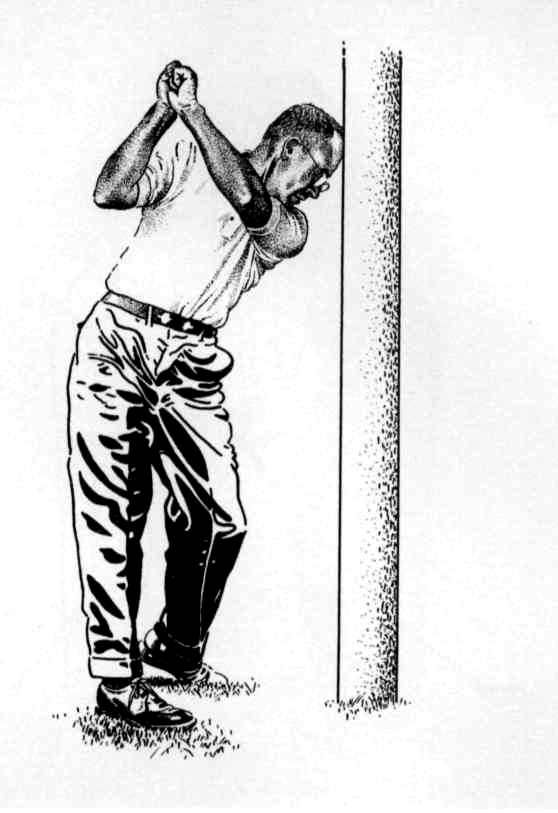
3. Improperly fitted clubs that are too “whippy” for your swing
Too flexible a club shaft can produce fat shots even though the player’s address position and swing are correct. Clubs that are too whippy cause a vibratory cycle, or bending in the shaft, which is so great that the club head drags along the ground.
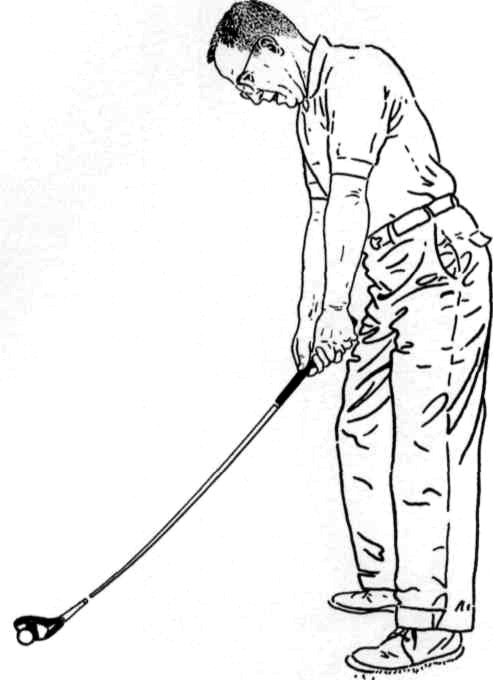
Fix: Check shaft flex
Anyone who has troubles with fat shots should consult his pro about the possibility of using stiffer shafts. This is especially good advice for players who are strong and have forceful swings with a great deal of club head speed.
A strong player sacrifices control if he uses too-whippy shafts, just as a weak swinger (women golfers take note) might lose club head speed by using too stiff a shaft.
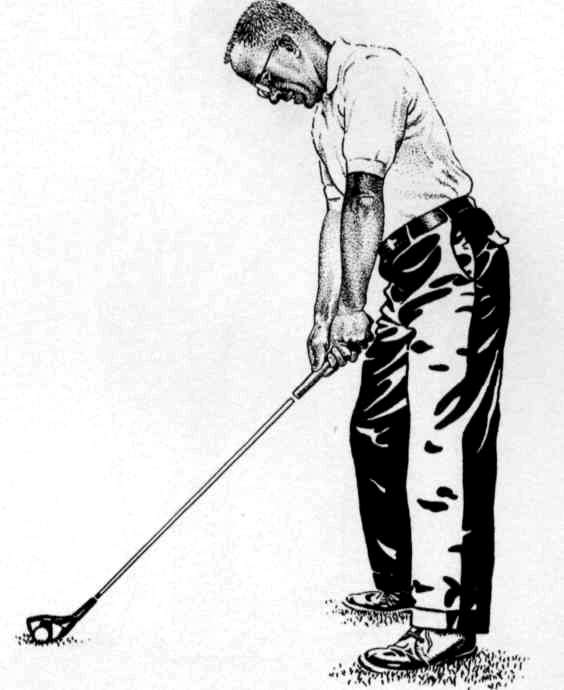
4. During the swing, increasing the angle formed by the arms and club shaft
The most subtle reason for fat shots occurs when the player, during the swing, causes the arms and club shaft to form more of a straight line than they did at address.
In a proper address position the arms should hang almost vertically, at about an 85 degree angle (Angle A’). The club shaft is supported in a somewhat more horizontal position (Angle C).
Together they form an angle of less than 180 degrees (Angle B’). If, during the swing, the player increases the angle formed by his arms and club shaft so that they form more of a straight line (angle B), the old principle that a straight line reaches farther than a crooked one of the same length comes into effect. The club head extends beyond the ball or into the ground.

Fix: Maintain the same arm-club angle at impact that you assumed at the address position
To keep this angle (B’) constant at address and impact the golfer should first address the ball with his arms and club shaft positioned in about the same manner as in the “correct” drawing above. Arms hang at about an 85° angle.
Then he should maintain the same amount of grip pressure throughout the swing. If he maintains constant grip pressure during the swing, the golfer will avoid arching his wrists. He will thus be able to hold the proper armclub angle (B’).
Also one should practice hefting his club vertically in front of him so that he becomes aware of the hand and forearm muscles that increase or decrease angle B’.

Related Post: How to stop topping the golf ball



